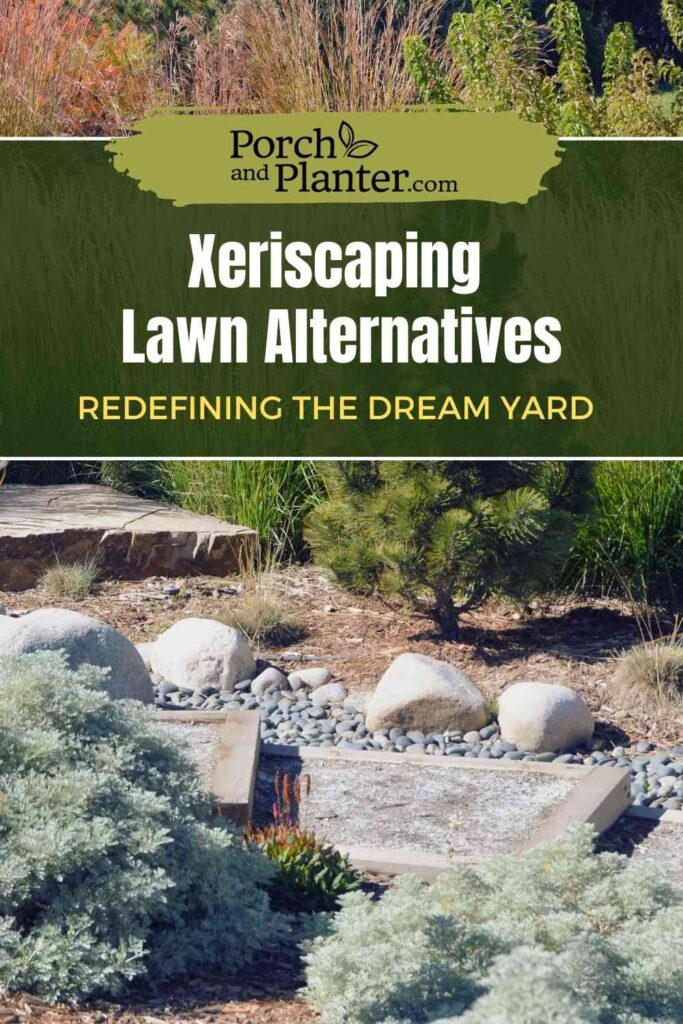Xeriscaping Lawn Alternatives: Redefining the Dream Yard

Traditional lawns, with their lush green expanses of grass, have long been a staple of landscaping in many parts of the world. However, with increasing concerns about climate change, water scarcity, and environmental sustainability, there is a growing need for more responsible and eco-friendly landscaping practices. This is where xeriscaping lawns come into play, offering a forward-thinking approach to redefining traditional lawns and embracing a more sustainable future.
The Limitations of Traditional Lawns
Traditional lawns have several environmental challenges and drawbacks. They require excessive water usage, often leading to wasteful water consumption and contributing to water scarcity in regions with limited water resources or prone to drought. Traditional lawns also rely heavily on chemical inputs, such as fertilizers and pesticides, which can have negative impacts on soil health, water quality, and wildlife. Moreover, the extensive mowing, watering, and maintenance required for traditional lawns can be time-consuming, labor-intensive, and costly, leading to high maintenance bills and carbon emissions from gas-powered equipment. In light of these limitations, there is a need for more sustainable alternatives to traditional lawns.
The Advantages of Xeriscaping Lawns
Xeriscaping lawns offer numerous advantages over traditional lawns, making them an ideal choice for sustainable landscaping. One of the main benefits of xeriscaping lawns is water conservation. Traditional lawns require a significant amount of water to maintain their lush green appearance, especially in areas with limited water resources or prone to drought. In contrast, xeriscaping lawns are designed to be water-wise, using plants that are adapted to local climate conditions and require minimal irrigation once established. This not only helps to conserve water but also reduces water bills, making xeriscaping lawns a cost-effective option in the long run.
Another advantage of xeriscaping lawns is reduced maintenance. Traditional lawns often require frequent mowing, fertilizing, and pest control, which can be time-consuming and costly. Xeriscaping lawns, on the other hand, typically require less maintenance as they are designed to be low-maintenance and self-sustaining once established. This allows homeowners to save time, effort, and money on lawn care, while also reducing the use of chemicals and synthetic fertilizers that can harm the environment.
In addition to water conservation and reduced maintenance, xeriscaping lawns also offer environmental sustainability benefits. Xeriscaping lawns are designed to promote biodiversity by using native plants that are adapted to the local ecosystem. These native plants provide habitat for local wildlife, support pollinators such as bees and butterflies, and conserve natural resources by reducing the need for fertilizers, pesticides, and herbicides. Xeriscaping lawns also help to reduce soil erosion, improve soil health, and enhance overall ecosystem resilience, making them an environmentally responsible choice for landscaping.
Designing and Implementing Xeriscaping Lawns
Xeriscaping lawns require careful planning and consideration of key principles, including plant selection, spacing and arrangement, soil preparation, and efficient irrigation. Native plants adapted to the local climate and soil conditions should be chosen and arranged in a way that mimics natural plant communities. Proper soil preparation, including well-drained soil amended with organic matter, is crucial. Efficient irrigation techniques such as drip irrigation or soaker hoses are recommended, along with rainwater harvesting systems. Creativity and innovation can also play a role in designing xeriscaping lawns, with artistic elements and hardscapes adding visual interest and functionality.
Maintenance is necessary for xeriscaping lawns, including pruning, weeding, and monitoring for pests and diseases. Proper irrigation is crucial, with careful monitoring of soil moisture levels and adjustments as needed to avoid overwatering or underwatering. Regular monitoring and adjustments may also be necessary to ensure the lawn is performing as intended, including plant replacements or changes to the irrigation system or mulch. Keeping a close eye on the overall health and performance of the xeriscaping lawn and making timely adjustments will help ensure its long-term success. Minimizing or avoiding the use of chemical pesticides and herbicides aligns with the principles of sustainability and environmental stewardship.
Overcoming Challenges and Maximizing Benefits
Adopting xeriscaping lawns may pose challenges such as initial costs, plant establishment, and aesthetics. The upfront investment for transitioning to a xeriscaping lawn, including removing existing turf, installing efficient irrigation systems, and purchasing drought-tolerant plants, may require careful budgeting and planning. Proper plant selection and placement, using native or adapted plants suited to local conditions, can improve plant establishment. Aesthetics can be addressed through thoughtful design and incorporation of a variety of textures, colors, and hardscaping elements.
However, the long-term benefits of xeriscaping lawns are significant. Reduced water bills are a major advantage, as xeriscaping lawns minimize the need for supplemental irrigation and can significantly reduce water use, especially in regions with high water costs or restrictions. Lower maintenance costs are also a benefit, as xeriscaping lawns typically require less mowing, fertilizing, and watering compared to traditional lawns, saving time, effort, and money. Positive environmental impacts are another benefit, as xeriscaping lawns contribute to water conservation, reduce the need for chemicals, and promote biodiversity through the use of native or adapted plants that provide habitat for local wildlife.
Practical solutions such as proper plant selection, efficient irrigation, appropriate maintenance practices, and homeowner education can help overcome challenges and maximize the benefits of xeriscaping lawns. Collaboration with landscape professionals and local water agencies can also play a significant role in the successful implementation of xeriscaping lawns. Overall, xeriscaping lawns offer long-term sustainability, financial prudence, and positive environmental impacts, making them a viable option for homeowners seeking to conserve water, reduce maintenance costs, and promote a healthy ecosystem.
The Future of Lawns: Embracing Xeriscaping
Xeriscaping lawns are gaining popularity as a sustainable landscaping solution that aligns with the evolving needs and values of our changing world. With increasing awareness about water scarcity, climate change, and environmental sustainability, more and more homeowners are embracing xeriscaping as an environmentally responsible landscaping option.
Xeriscaping lawns have the potential to become the future of lawns due to their numerous benefits that align with the principles of sustainability. As water resources become scarcer and more precious, the need for water-wise landscaping solutions like xeriscaping lawns becomes even more critical. The ability to reduce water use, lower maintenance costs, and promote environmental health makes xeriscaping lawns a compelling choice for homeowners who are mindful of their impact on the environment and want to contribute to a more sustainable future.
Furthermore, xeriscaping lawns can play a significant role in promoting resilience in landscapes. With their ability to thrive in drought-prone regions, xeriscaping lawns can withstand challenging weather conditions and maintain their beauty and functionality even during periods of water scarcity. This resilience can help homeowners adapt to changing environmental conditions and reduce the reliance on precious water resources, making xeriscaping lawns a viable solution for creating sustainable landscapes that can withstand the test of time.
In addition to their environmental benefits, xeriscaping lawns also offer social and economic benefits. By reducing water bills and maintenance costs, homeowners can save money in the long run, providing financial incentives for embracing xeriscaping as a landscaping option. Xeriscaping lawns can also enhance the curb appeal and value of a property, as more homebuyers are becoming interested in sustainable and water-wise landscaping options. This trend is further driving the demand for xeriscaping lawns and positioning them as a forward-thinking approach to redefining traditional lawns.
Conclusion
In conclusion, xeriscaping lawns offer a sustainable and environmentally responsible approach to landscaping that can help redefine the concept of a dream yard. Despite potential challenges such as initial costs, plant establishment, and aesthetics, practical solutions and strategies can be implemented to overcome these challenges and maximize the benefits of xeriscaping lawns. The long-term benefits of reduced water bills, lower maintenance costs, and positive environmental impacts make xeriscaping lawns a compelling option for homeowners who are looking to create beautiful, resilient, and eco-friendly landscapes.
As the popularity of xeriscaping lawns continues to grow, they have the potential to become the future of lawns, promoting a more sustainable and water-wise approach to landscaping. By embracing xeriscaping lawns, homeowners can contribute to a more resilient, sustainable, and eco-friendly landscaping approach for future generations. It’s time to rethink the traditional concept of lawns and consider xeriscaping lawns as a viable and responsible landscaping option that aligns with the evolving needs and values of our changing world. Let’s embrace xeriscaping and pave the way for a greener, more sustainable future.


